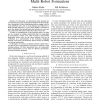Free Online Productivity Tools
i2Speak
i2Symbol
i2OCR
iTex2Img
iWeb2Print
iWeb2Shot
i2Type
iPdf2Split
iPdf2Merge
i2Bopomofo
i2Arabic
i2Style
i2Image
i2PDF
iLatex2Rtf
Sci2ools
ICRA
2005
IEEE
2005
IEEE
Path Planning for Permutation-Invariant Multi-Robot Formations
— In this paper we demonstrate path planning for our formation space that represents permutation-invariant multirobot formations. Earlier methods generally pre-assign roles for each individual robot, rely on local planning and behaviors to build emergent behaviors, or give robots implicit constraints to meet. Our method first directly plans the formation as a set, and only afterwards determines which robot takes which role. To build our representation of this formation space, we make use of a property of complex polynomials: they are unchanged by permutations of their roots. Thus we build a characteristic polynomial whose roots are the robot locations, and use its coefficients as a representation of the formation. Mappings between work spaces and formation spaces amount to building and solving polynomials. In this paper, we construct an efficient obstacle collision detector, and use it in a local planner. From this we construct a basic roadmap planner. We thus demonstrate that our...
Formation Spaces | ICRA 2005 | Permutation-invariant Multirobot Formations | Robotics | Robots Implicit Constraints |
| Added | 25 Jun 2010 |
| Updated | 25 Jun 2010 |
| Type | Conference |
| Year | 2005 |
| Where | ICRA |
| Authors | Stephen Kloder, Seth Hutchinson |
Comments (0)

